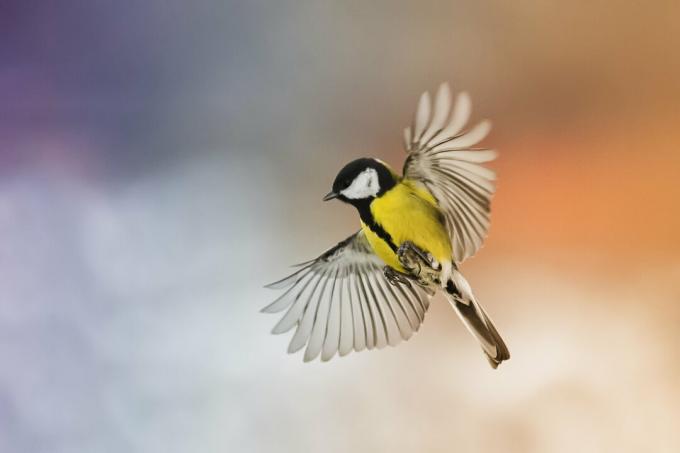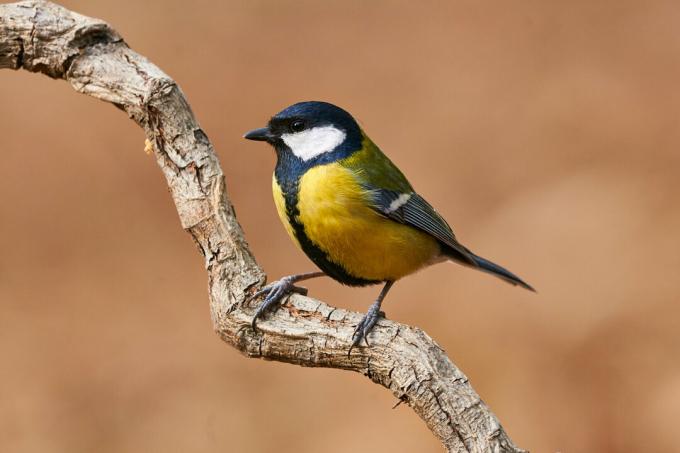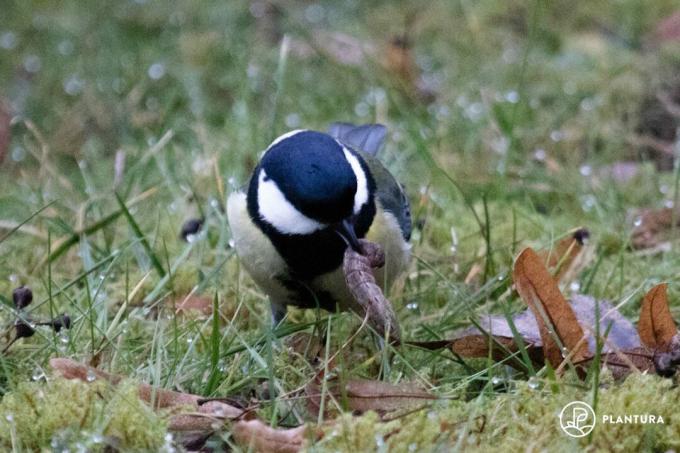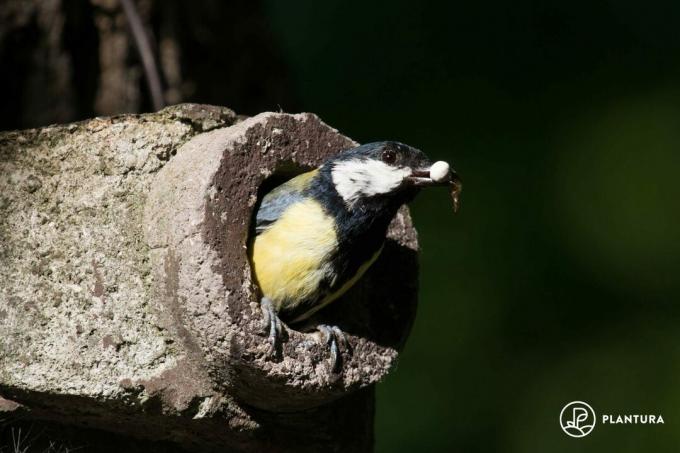When and how often do great tits breed? How do you recognize the great tit and where does it feel comfortable in the garden? We reveal everything about the habitat, suitable food and breeding season of the great tit.

The great tit (Parus major) is the largest and most common species of tit in Central Europe. She is also popularly known by the names Kohlheinz, Cheeky Meise or Zizibe – the latter is reminiscent of her catchy singing. Great tits do not shy away from human neighbors and are therefore very common in parks and gardens. They are also very happy to accept our help in the form of nesting aids and feeding places and thus prove to be adaptable and uncomplicated contemporaries. Here you can find out everything else you need to know about the commonplace bird, the great tit.
contents
- Great tits: A detailed profile
-
How to recognize the great tit
- What does the song of the great tit sound like?
- How do you recognize the young birds of the great tit?
- How do you recognize great tit eggs?
- How do female and male great tits differ?
- Which habitat do great tits prefer?
- Where do they build their nest?
- When do great tits breed?
- Where do great tits spend the winter?
-
Support great tits: That's how it works
- What do great tits eat?
- Nesting boxes for great tits: entry hole, location and more
- How can you provide additional support for great tits?
Great tits: A detailed profile
| size | About 14cm |
| Weight | About 20g |
| breeding season | March - July |
| lifespan | About 5 years |
| habitat | Light deciduous and coniferous forests, gardens, hedgerows |
| feed preference | Insects, oil rich seeds and nuts, fruits |
| threats | Decrease in natural habitat and food supply |
How to recognize the great tit
As the name suggests, the great tit has a shiny, deep black head, which is broken only by large, white cheek areas. Its back is moss green and its elytra blue-grey. The ventral side is yellow and is traversed in the middle by a black longitudinal stripe. This chest band is also a special feature for the great tit males: it serves as a status symbol. Birds with a wider band are considered higher in the ranking and tend to occupy the better territories.
At first glance, the great tit is easy to deal with blue tit to confuse. However, this is a bit smaller and, in contrast to the great tit, has a blue crown.

What does the song of the great tit sound like?
The great tit has a very variable song and a large repertoire. The most distinctive stanza, by which the species can always be identified, is a repeating two-syllable "zi-be" or three-syllable "zi-zi-be" composed of loud, clear tones. In addition, the great tit has several calls and the "crying" typical of tits.
This is how the song of the great tit sounds:
How do you recognize the young birds of the great tit?
The young great tits are already very similar to the adult animals – however, their plumage is somewhat paler than that of the adult birds and the dark head is more of a slate grey. The cheek areas are a dirty yellow and not yet separated from the rest of the body by the strong black collar, as with the parents.

How do you recognize great tit eggs?
The great tit's eggs are glossy white and dotted with light brown, slightly reddish speckles, which are particularly concentrated on the blunt end. The eggs, which are 1.8 centimeters high and 1.4 centimeters wide, are laid in a nest made of moss and grass, which is padded with hair and feathers. Great tits lay between 8 and 12 eggs per brood.

How do female and male great tits differ?
It takes a little practice to distinguish female great tits from their mates. The most obvious feature is the black chest band, which is narrower and paler in females than in males and is sometimes even interrupted. The yellow on the breast and abdomen of the female great tits is also somewhat less intense.

Which habitat do great tits prefer?
Great tits prefer to breed in old mixed and deciduous forests, which are rich in old trees with cavities for nesting. However, they were able to adapt excellently to the spread of man-made habitats and are also found in large numbers in parks and gardens today.
Where do they build their nest?
Great tits are cavity nesters and prefer natural tree cavities as nesting sites. Old woodpecker holes are also used for this. In cities and settlements, however, the supply of such structures is small - fortunate that the little birds have proven to be extremely inventive. They use wall cracks, cavities under roof tiles and even mailboxes. They also accept nest boxes very well.

When do great tits breed?
The breeding season of the great tit lasts from March to July. The exact start of breeding depends on the temperatures in spring and can vary by a few weeks. Great tits usually raise only one brood per season, but a second may join them under certain circumstances. The incubation period lasts 14 days and the young are then fed in the nest for about 20 days. After that they make their first attempts to fly, but as so-called fledglings who are not yet able to take care of themselves, they are dependent on their parents for another two weeks.
Where do great tits spend the winter?
Our native great tits are sedentary birds, which means that they do not stray far from their breeding grounds even in winter and do not migrate south. Only their conspecifics in more northern countries sometimes migrate south to escape the harsh winters there. In general, the great tit is therefore considered a partial migrant.

Support great tits: That's how it works
Especially in cold winters, great tits are dependent on feeding stations, as their natural food sources are difficult to access. These are very well received and are also ideal for exciting ones bird watching. In addition, nesting boxes can be offered, as well as numerous bird friendly plants.
What do great tits eat?
Great tits feed on insects, spiders, seeds, nuts and fruits. In winter, oily nuts and seeds are a particularly important food source. Anyone who wants to feed their cats should therefore use fat feed mixtures or suet balls that have a high fat content. Pure sunflower seeds, broken peanuts or mealworms can also be offered. You can give your garden tits a special treat with our Plantura fat balls. Because these are composed of pure insect fat as well as valuable nuts, seeds and berries and therefore offer a high-quality and energy-rich food source. In addition, our tit dumplings do not require any plastic nets, in which the small songbirds could get their feet entangled and injure themselves.

Plantura fat balls
Sustainable fat balls without a net,
Species-appropriate wild bird food with insect fat for year-round feeding
tip: If you want to keep an eye on the components of the food, you can do it very easily Make bird seed yourself.

Nesting boxes for great tits: entry hole, location and more
Great tits are not particularly critical of human help and are therefore very happy to accept nest boxes for rearing their brood. These should be closed all around except for an entry hole in order to simulate the structure of a natural tree cavity. The entry hole for great tits should have a diameter of 32 mm. The nest box is preferably attached to a tree trunk at a height of a few meters - with the opening facing east or south-east.
tip: In our article “Build your own nest boxYou will not only learn how you can easily build the perfect bird box yourself, you will also get practical tips on materials, colors and cleaning.

How can you provide additional support for great tits?
During the breeding season, the young great tits are mainly fed with caterpillars, the supply of which in the garden is often much smaller than in the forest. In fact, great tits have been shown to lay fewer eggs in gardens than in their natural habitat. Popular food plants for caterpillars, such as blackberries, stinging nettles, willow or sloe, can help here. This also comes to the little sister of great tit, theblue tit, because she feeds her offspring mainly with caterpillars. Garden birds find it difficult to find water, especially in hot summers and sealed cities. One bird bath or a well-filled trivet can not only be used by the great tit, but also by the robin, bring a lot of joy.
...and receive concentrated plant knowledge and inspiration directly in your e-mail inbox every Sunday!



